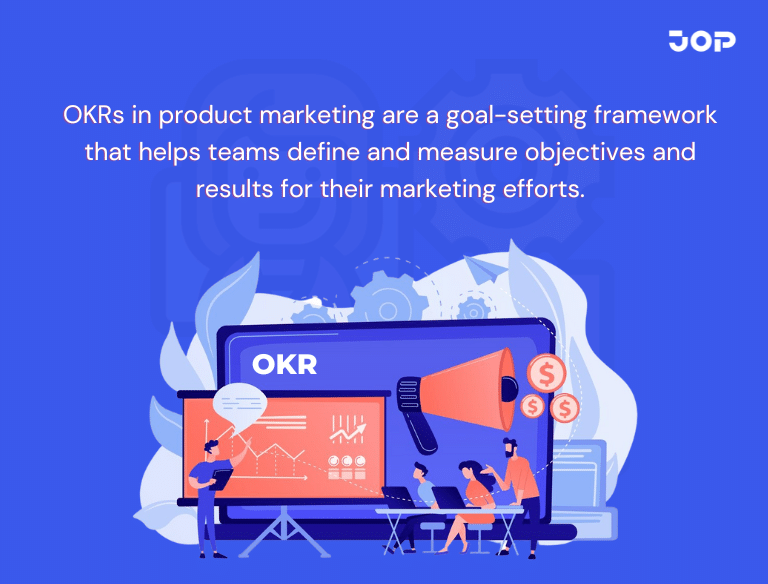Feeling overwhelmed with tracking your product marketing goals and not seeing the results you want?
In this blog, we’ll dive deep into what OKRs really mean in the world of product marketing, how they differ from KPIs and the key focus areas and product marketing OKR examples that can help boost your marketing efforts. With the help of Okr software, you can streamline goal tracking and alignment for better results.
Stick around to uncover the secrets of crafting product marketing OKRs and the best practices to help you supercharge your product to make it work like a charm.

What is OKR in product marketing?
OKRs in product marketing are a strategic framework that helps product marketers set and measure their goals. Objectives are high-level, qualitative goals that outline what a product marketing team aims to achieve.
They should be specific, measurable, and time-bound. Key Results, on the other hand, are specific, quantifiable metrics that indicate progress toward achieving the objectives. They serve as measurable indicators of success and help teams stay focused on their priorities.
In product marketing, OKRs can be used to align teams, track progress, and drive the success of product launches, customer engagement, and overall product promotion efforts.
By using OKRs, product marketing professionals can ensure that their efforts are aligned with the company’s broader objectives and can effectively measure and improve their performance.
Product marketing OKRs vs KPIs
In product marketing, both OKRs and KPIs are important for understanding how well your marketing strategies are working. Here’s how they relate to your work:
Product marketing OKRs:
Objectives: When you set OKRs for product marketing, you’re deciding what you want to achieve, like launching a new product successfully, reaching more customers, or expanding into new markets. These objectives give you a clear target to aim for.
Key Results: Key Results are the specific ways you measure your progress toward your objectives. They can include things like the number of successful product launches, the percentage of market share you’ve gained, or the number of new markets you’ve entered.
Product marketing KPIs:
Key Performance Indicators: KPIs help you keep track of how well your specific marketing activities are performing. They show you how many people are engaging with your product, how many of them are turning into customers, and how happy they are with your product.
For example, your KPIs could be the number of website visitors, the conversion rate of those visitors into customers, or the satisfaction scores from your customers.
Using both OKRs and KPIs in your product marketing work allows you to set clear goals and measure your progress toward those goals.
They help you understand what’s working well and what might need improvement so you can make informed decisions to keep your marketing efforts on track.
Key focus areas for product marketing objectives
1. Go-to-market strategy
This section focuses on the goals and outcomes associated with launching and promoting a product.
It includes activities like identifying the target audience, crafting messages and positioning, and determining distribution channels.
Some examples of Go-to-Market objectives may involve achieving a specific market share, launching in particular regions, or successfully establishing the product in the market.
2. Enabling sales
This category involves objectives and outcomes that support the sales team in effectively selling the product.
It includes creating materials to aid sales, providing product training, and equipping the sales team with the necessary tools and resources to close deals.
Examples of Enabling Sales objectives may include improving the sales team’s knowledge of the product, increasing success rates, or shortening the sales cycle.
3. Generating leads and demand
This section focuses on objectives and outcomes related to generating interest and demand for the product among potential customers.
It involves strategies for lead generation, demand generation, and creating marketing campaigns to attract prospects.
Examples of Leads and Demand Generation objectives may include achieving a specific number of leads, increasing website traffic, or improving conversion rates for marketing campaigns.
4. Product adoption strategy
This category is about setting objectives and outcomes related to encouraging existing customers to adopt and use the product more effectively.
It involves educating customers, promoting the use of product features, and ensuring customer satisfaction and loyalty.
Examples of Product Adoption objectives may include increasing user engagement, reducing customer churn, or expanding product usage within existing accounts.
Crafting product marketing OKRs
Writing effective OKRs for product marketing requires careful consideration and a deep understanding of your product, market, and overall business objectives. Below is a more detailed formula for creating comprehensive OKRs for product marketing:
1. Understand your product and market
Take the time to know exactly what makes your product different from others. Understand its unique features and benefits.
Identify the specific group of people who are most likely to be interested in buying your product. Understand their needs, preferences, and behaviors.
Conduct thorough research on your competitors to identify their strengths, weaknesses, and strategies. This understanding can help you position your product more effectively in the market.
2. Set clear objectives
Goal 1: If you want more people to know about your brand, focus on increasing brand visibility and awareness through various marketing channels such as social media, content marketing, and advertising.
Goal 2: To encourage more people to use your product, aim to improve user engagement and adoption by providing clear and compelling value propositions and a seamless user experience.
Goal 3: If you’re aiming to increase interest in buying your product, concentrate on generating more high-quality leads that have a higher potential to convert into customers.
3. Establish key results
For Goal 1, track metrics such as the percentage increase in social media engagement, including likes, shares, and comments, over a specific period.
For Goal 2, monitor website traffic growth and the conversion rate from organic search to assess how well you’re attracting and retaining users.
For Goal 3, keep a close eye on the number and quality of leads generated through your email campaigns and content marketing efforts.
4. Make sure you can measure it
Ensure that the Key Results you set are measurable and specific. Avoid vague or ambiguous metrics that could make it difficult to evaluate your progress accurately.
Use concrete data points, such as specific numbers or percentages, to assess your performance objectively.
5. Connect to the company’s goals
Your Product Marketing OKRs should align with the broader objectives of your company. Make sure your marketing efforts contribute to the company’s growth, revenue targets, and overall vision.
Align your marketing goals with the company’s mission and values, ensuring that they reflect the organization’s long-term priorities.
6. Foster collaboration and communication
Encourage collaboration and communication between different teams, such as product development, marketing, and sales.
Foster a culture of teamwork and shared goals to ensure that everyone is working towards the same objectives.
Regularly communicate progress updates, challenges, and successes to keep everyone informed and engaged.
7. Regular evaluation and adjustments
Continuously monitor and analyze the progress of your Product Marketing OKRs. Regularly review the Key Results to identify any trends or patterns that may require adjustments to your marketing strategies.
Be open to making necessary changes and adaptations based on the insights and feedback you gather from your target audience and market analysis.
8. Celebrate the good stuff
Recognize and celebrate the achievements and milestones reached during the OKR cycle. Acknowledge the hard work and dedication of the team members involved in achieving the set objectives and key results.
Celebrate small wins and major accomplishments to boost team morale and motivation, fostering a positive and supportive work environment.
15 empowering product marketing OKR examples
Product marketing OKRs are essential for setting and measuring goals within the realm of product marketing. Here are several types of product marketing OKRs that companies commonly use:
1. Launching a new product feature
Objective: Successfully launch a new product feature.
Key Results:
- Achieve a 90% user adoption rate within the first month.
- Increase customer satisfaction score by 15% following the feature launch.
- Obtain positive feedback from at least 80% of beta testers.
2. Improving product messaging strategy
Objective: Refine the product messaging to resonate with the target audience.
Key Results:
- Conduct customer surveys to understand messaging effectiveness, achieving a 20% response rate.
- Increase website conversion rates by 10% through revised messaging.
- Attain a 25% increase in brand mentions on social media platforms.
3. Enhancing product user experience (UX)
Objective: Enhance the overall user experience of the product.
Key Results:
- Reduce product onboarding time by 20% for new users.
- Achieve a 15% increase in the app store rating.
- Decrease the number of customer support inquiries related to usability issues by 30%.
4. Implementing a competitive analysis strategy
Objective: Understand the competitive landscape and refine product positioning.
Key Results:
- Conduct in-depth competitive analysis for at least 5 key competitors.
- Identify 3 key areas of differentiation and leverage them in marketing collateral.
- Achieve a 10% increase in market share within the targeted competitor segment.
5. Optimizing product pricing strategy
Objective: Enhance the product’s pricing strategy for improved market competitiveness.
Key Results:
- Conduct pricing analysis on at least 3 competing products.
- Implement dynamic pricing to increase overall revenue by 15%.
- Achieve a 10% increase in customer satisfaction related to pricing transparency.
6. Increasing product trial conversions
Objective: Improve the conversion rate from product trials to paid subscriptions.
Key Results:
- Increase the trial-to-paid conversion rate by 20%.
- Achieve a 10% decrease in the product trial dropout rate.
- Attain a 25% increase in the number of active paid subscriptions.
7. Developing a comprehensive product marketing plan
Objective: Create a holistic marketing strategy to promote the product.
Key Results:
- Develop and launch a targeted email marketing campaign with a 25% open rate.
- Execute a successful product launch event with at least 500 attendees.
- Secure partnerships with 3 key influencers for product endorsements.
8. Improving product SEO and online visibility
Objective: Increase the product’s online visibility through improved SEO strategies.
Key Results:
- Achieve a 30% increase in organic search traffic to the product website.
- Rank within the top 3 search results for at least 5 relevant industry keywords.
- Attain a 20% increase in backlinks from reputable websites to the product page.
9. Expanding product reach to new markets
Objective: Enter new markets to diversify the product’s customer base.
Key Results:
- Conduct market research to identify 3 viable new market segments.
- Successfully launch the product in at least 2 new geographic regions.
- Achieve a 15% increase in sales within the new market segments.
10. Implementing customer-driven product improvements
Objective: Enhance the product based on customer feedback and suggestions.
Key Results:
- Implement 5 key product improvements based on customer feedback.
- Achieve a 20% decrease in customer complaints related to product functionality.
- Increase customer satisfaction scores by 25% through product updates.
11. Building a strong customer community
Objective: Foster a thriving customer community around the product.
Key Results:
- Increase engagement on the product’s online forum by 30%.
- Host 3 successful virtual customer meetups with a participation rate of at least 100 customers.
- Achieve a 20% increase in user-generated content related to the product.
12. Launching a product rebranding campaign
Objective: Revamp the product’s brand image and messaging.
Key Results:
- Successfully executed a rebranding campaign with 90% positive sentiment from customers.
- Achieve a 15% increase in brand awareness following the rebrand.
- Enhance brand perception among the target demographic, as evidenced by a 25% increase in positive brand associations.
13. Improving product sales enablement
Objective: Equip the sales team with effective tools and resources for promoting the product.
Key Results:
- Develop and distribute a comprehensive product sales playbook to the sales team.
- Provide training sessions to the sales team, resulting in a 20% increase in product knowledge.
- Achieve a 15% increase in the average sales deal size following the implementation of new sales enablement strategies.
14. Enhancing cross-sell and upsell opportunities
Objective: Increase revenue through cross-selling and upselling existing customers.
Key Results:
- Implement a cross-selling strategy that results in a 20% increase in average order value.
- Attain a 25% increase in the adoption rate of premium product features through upselling.
- Achieve a 15% increase in customer lifetime value through cross-selling and upsell initiatives.
15. Streamlining product communication channels
Objective: Improve communication channels for product updates and announcements.
Key Results:
- Implement a monthly product newsletter with a 25% open rate and 10% click-through rate.
- Increase engagement on the product’s social media channels by 30% through regular updates and announcements.
- Achieve a 20% increase in customer satisfaction with the clarity and timeliness of product communications.
Best practices for setting effective product marketing OKRs
When establishing OKRs for product marketing specifically, it is essential to consider the unique challenges and opportunities that arise in this domain. Here are some best practices for setting effective product marketing OKRs:
1. Product positioning and messaging
Develop objectives that focus on refining the product’s positioning and messaging to effectively communicate its value proposition to the target audience.
Key results could include metrics related to brand recognition, customer perception, and messaging consistency across different marketing channels.
2. Product launch and adoption
Set objectives that aim to drive successful product launches and maximize product adoption within the target market.
Key results might involve metrics such as the number of successful product launches, user acquisition rates, and the growth of active users or customers.
3. Customer engagement and retention
Establish objectives that prioritize fostering customer engagement and improving customer retention rates.
Key results could include metrics related to customer satisfaction, customer lifetime value, and the effectiveness of customer engagement initiatives such as personalized marketing campaigns or loyalty programs.
4. Market analysis and customer insights
Incorporate objectives that emphasize conducting thorough market analysis and gathering valuable customer insights to inform product marketing strategies.
Key results might involve metrics related to customer feedback, market research findings, and the identification of customer pain points and preferences.
5. Competitive analysis and differentiation
Set objectives that focus on understanding the competitive landscape and developing strategies to differentiate the product from competitors.
Key results could include metrics related to market share, competitive positioning, and the effectiveness of differentiation strategies in capturing the target audience’s attention.
6. Marketing campaign effectiveness
Establish objectives that aim to measure the effectiveness of marketing campaigns in generating leads and conversions.
Key results might involve metrics related to lead generation, conversion rates, and the return on investment (ROI) of various marketing initiatives.
7. Product education and empowerment
Develop objectives that prioritize educating and empowering the target audience about the product’s features, benefits, and use cases.
Key results could include metrics related to customer education initiatives, such as the number of educational resources created, customer feedback on the effectiveness of educational materials, and the impact of education on product adoption rates.
8. Cross-functional collaboration
Encourage collaboration between product marketing, sales, and product development teams to ensure that the product marketing OKRs align with the overall product strategy and business goals.
Key results might involve metrics related to cross-functional communication, collaboration effectiveness, and the successful integration of marketing insights into the product development process.
Conclusion
In the world of product marketing, OKRs work as a plan that helps teams come together to reach business goals. Unlike traditional Key Performance Indicators (KPIs) that only measure performance, OKRs focus on setting big goals and specific steps to get there.
This builds a culture of always getting better. By picking out important areas like getting more customers, making the product stand out, and understanding the competition, businesses can use product marketing OKRs to guide their work in the right direction.
Using good OKR software makes it easy for teams to set, keep track of, and review their goals. This means they can quickly change strategies if needed and make sure the product does well.
Following the best ways to create and use product marketing OKRs can help businesses stay ahead, be more creative, and grow steadily in today’s fast-changing market.

Nishant Ahlawat
Growth Marketer
Nishant Ahlawat is a Growth Marketer and Strategic Content Specialist, dedicated to driving scalable business success. With expertise in crafting data-driven strategies, optimizing content for engagement, and leveraging performance marketing, Nishant focuses on accelerating growth. His approach combines innovation, audience insights, and conversion optimization to create sustainable impact. Passionate about staying ahead in the fast-evolving digital landscape, he empowers businesses with strategies that fuel measurable results. Read More
 Nishant Ahlawat
Nishant Ahlawat
